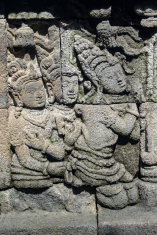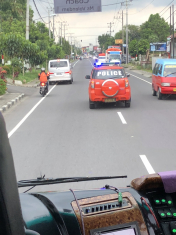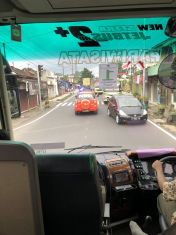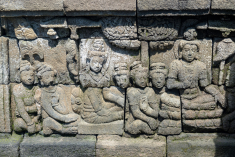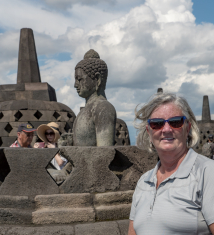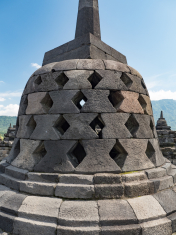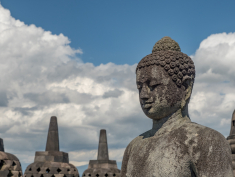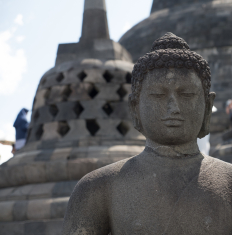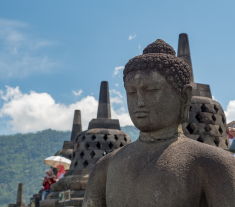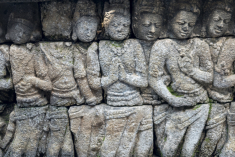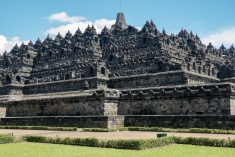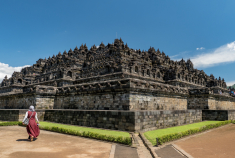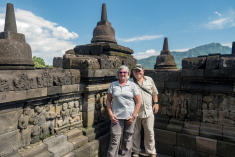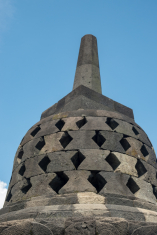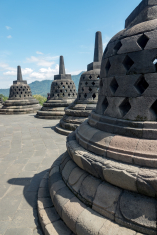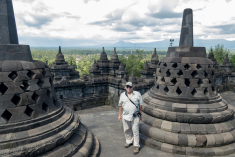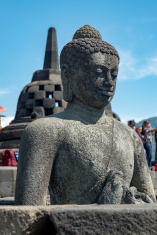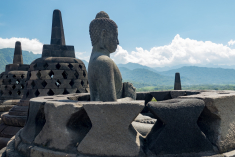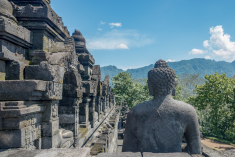Along with Angkor Wat in Cambodia and Bagan in Myanmar, Java’s Borobudur makes the rest of Southeast Asia’s spectacular sites seem almost incidental. Looming out of a patchwork of bottle-green paddies and swaying palms, this colossal Buddhist monument has survived volcanic eruptions, terrorist bombs and an earthquake to remain as enigmatic and as beautiful as it must have been 1200 years ago.
From a distance Borobudur gives the appearance of a step pyramid: row upon ascending row of stone galleries, built upon a hill that dominates the plains and rice fields of south-central Java. Pilgrims have been coming here for 1,200 years to marvel at the thousands of sculptured figures carved into the lower tiers of Borobudur. These figures are meant to teach. Like the narrative statuary crowding the walls of a Cathedral, Borobudur’s carvings conveyed the insights of faith in a sequential storytelling framework that would have been accessible to the educated and unlettered alike.
The vast 9th century structure is the world’s largest Buddhist temple. Almost 90 feet high and decorated with more than 500 Buddha statues, it includes three central platforms adorned with 72 Buddhas, each one seated inside a huge, perforated stone stupa. Borobudur is built from two million stone blocks in the form of a massive symmetrical stupa, literally wrapped around a small hill. Standing on a 360 x 360 foot base, its six square terraces are topped by three circular ones, with four stairways leading up through carved gateways to the top. The top platforms are circular, signifying never ending nirvana. Viewed from the air, the structure resembles a colossal three-dimensional tantric mandala. Although Borobudur is impressive for its sheer bulk, the delicate sculptural work when viewed up close is exquisite. There are nearly 1460 richly decorated narrative panels and 1212 decorative panels in which the sculptors have carved a virtual textbook of Buddhist doctrines as well as many aspects of Javanese life 1000 years ago — a continual procession of ships and elephants, musicians and dancing girls, warriors and kings. Many other panels are related to Buddhist concepts of cause and effect or karma.
Prominent among Borobudur’s sculptured tales are “birth stories” starting in the everyday world and spiraling up to nirvana, or enlightenment. These are legends that tell of Siddhartha’s earlier incarnations before he became the Buddha. In many of these tales the Buddha acquires merit by sacrificing his own selfish interests for the good of the other animals or humans he encounters. Most visitors, us included, hurry up the stairs to those monument’s summit. Here repose numerous statues of the Buddha shown seated in meditation. The Buddhas look out over palm groves and drops of tobacco and sugar cane to a horizon of limestone hills and volcanic mountains. Understandably, Borobudur is the most visited tourist site in Indonesia. With its palpable spirituality and striking architectural beauty, the huge stone temple draws pilgrims and tourists from around the globe. It is the kind of place that stays with you long after your return home.
The travel component took us about 60 miles in each direction between the dock and Borobudur. It is a journey that would take less than an hour on America’s interstate highway system but one that can take several hours on Central Java’s chaotic roads. Upon seeing a traffic jam during rush hour on our journey, one couple from Southern California remarked, “Los Angeles is nothing compared to this.”
Imagine a four-lane road with two lanes intended for travel in one direction and two intended for travel in the other. In most countries, this system works well. In Central Java, however, cars, trucks, busses and motorbikes often use all four lanes for travel in the direction that they are going. That solid white line running down the center of the road? In other countries, the line indicates that drivers should not cross over it and into the other lane. Here, the white line is merely a suggestion — and one that is often ignored. So how does a cruise company navigate three motor coaches through the maze of traffic? Meet the police escort.
Lights Flashing, Sirens Blasting
Holland America had arranged for a police escort to lead and accompany our 15 motor coaches from the dock in Semarang to Borobudur and back. With their blue lights flashing and sirens singing, one police car led the way with our motor coaches giving chase and another police car followed in pursuit. For two hours on the way to Borobudur, our busses wove in and out of traffic, across white lines, around cars and trucks — and often toward oncoming traffic, which pulled off the road to allow us to pass. “My husband normally naps on these long bus trips,” one woman told me at the end of the day. “He didn’t this time.”
Indeed, the journey was one not to be missed. Motorbikes came daringly close alongside and cut between our bus and other vehicles, with what appeared to be only inches to spare. Just in the nick of time, oncoming transport trucks obligingly pulled off the roads as we used their lanes to pass traffic. No anger, no road rage. Rather than resent us, many Javanese waved and smiled as we passed them. Nor did I get the sense that those on our busses feared for their safety. Quite the opposite. The experience was a bit like a thrill ride, a harrowing adventure along roads flanked by the busy life of Central Java and punctuated by beautiful rice terraces and tropical trees. Even with the police escort, covering 60 miles took about two hours, with a 15-minute coffee, snack (included) and restroom break built in about halfway along the journey.
Due to the traffic having the police escort was invaluable. The buses were able to use both sides of the road and went right through the traffic lights – no matter the color. For us, getting to/from the temple turned out to be the best part of the tour. It was was one of the most incredible drive. The police were unbelievable as they moved the traffic and maneuvered through trucks, motor bikes, ducks and cattle on the road was a wonder.


